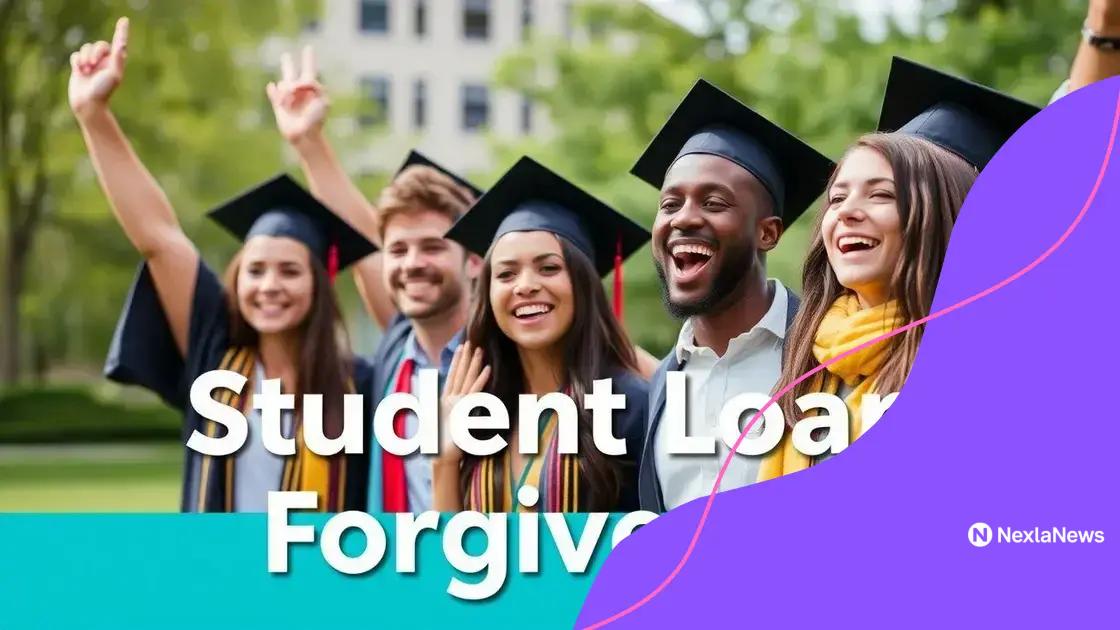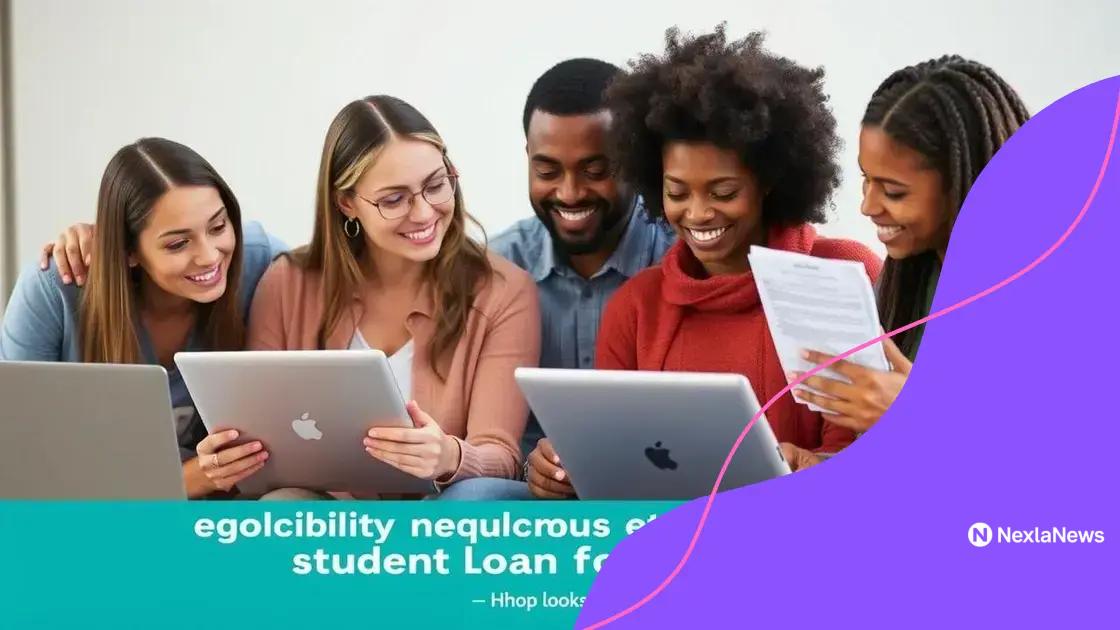Student loan forgiveness: a guide to relief options

Student loan forgiveness programs, including Public Service Loan Forgiveness and Teacher Loan Forgiveness, provide relief to eligible borrowers by canceling a portion or all of their federal student loans under specific conditions.
Student loan forgiveness can feel like a distant dream for many borrowers, but understanding how it works is key. What if you could reduce or eliminate your student debt? This article dives into the specifics of relief options available.
Understanding student loan forgiveness
Understanding student loan forgiveness is essential for anyone burdened by student debt. It is a way to reduce or eliminate your loan obligations under certain conditions. As you explore this option, it’s important to know how forgiveness works and who qualifies for it.
What is Student Loan Forgiveness?
Student loan forgiveness refers to the process where a portion or all of your federal student loans can be canceled. This can happen for several reasons, including working in public service or suffering financial hardship.
Types of Student Loan Forgiveness
There are several programs available that can help borrowers qualify for forgiveness:
- Public Service Loan Forgiveness: Available for borrowers working in eligible public service jobs.
- Teacher Loan Forgiveness: Aimed at teachers who work in low-income schools.
- Income-Driven Repayment Forgiveness: After a certain number of years of payments, some borrowers may have their remaining balance forgiven.
- Total and Permanent Disability Discharge: For those who are unable to work due to a disability.
Understanding these types can help you figure out which option might work for your situation. Additionally, each program has specific eligibility criteria that you need to meet.
It’s also worth noting that not all loans qualify for forgiveness. Federal loans, such as Direct Loans and Stafford Loans, typically qualify, while private loans do not. Therefore, it’s crucial to identify the type of loans you have.
If you think you might qualify for student loan forgiveness, the next step is to gather the necessary documentation. This will include your employment records, loan information, and any other supporting documentation required by the program you’re applying for. Ensure you keep track of deadlines, as they can vary.
By staying informed and proactive about your loans, you may find relief through one of these forgiveness programs, easing your financial burden significantly.
Types of forgiveness programs available
There are several types of forgiveness programs available for borrowers who are struggling with student loans. Each program has its own eligibility requirements and offers different benefits. Understanding these options is essential to find the one that best suits your situation.
Public Service Loan Forgiveness
This program is designed for those who work in public service jobs. If you have made 120 qualifying payments under a qualifying repayment plan while working for a qualifying employer, you may qualify for forgiveness of your remaining balance.
Teacher Loan Forgiveness
This program offers up to $17,500 in loan forgiveness for teachers who work full-time in low-income schools for five consecutive years. It’s a fantastic opportunity for educators who dedicate themselves to helping underserved communities.
Income-Driven Repayment Forgiveness
Under this program, your remaining loan balance may be forgiven after 20 or 25 years of qualifying payments, depending on your repayment plan. This forgiveness is available for federal student loans, making it a viable option for many borrowers.
Total and Permanent Disability Discharge
If you are unable to work due to a total and permanent disability, you may be eligible for a discharge of your federal student loans. This includes conditions like paralysis, blindness, or other disabilities.
Understanding these various forgiveness programs can help borrowers find the relief they need. It’s important to carefully review the eligibility criteria for each program and keep track of deadlines to maximize your chances of receiving forgiveness.
Eligibility criteria for student loan forgiveness

Determining the eligibility criteria for student loan forgiveness is a crucial step for borrowers seeking relief. Each forgiveness program has specific requirements that must be met to qualify.
General Eligibility Requirements
Typically, borrowers need to ensure they have federal student loans, as most programs do not apply to private loans. You must also be on a qualifying repayment plan and have made the requisite number of payments. It’s essential to stay informed about the program details.
Public Service Loan Forgiveness Eligibility
To qualify for this program, you must be employed full-time by a government or nonprofit organization. You’ll need 120 qualifying payments while working in a public service job. The loans must be Direct Loans, and you should consolidate any other federal loans into a Direct Consolidation Loan.
Teacher Loan Forgiveness Eligibility
For teachers, you need to serve at an eligible low-income school or educational service agency for five consecutive years to qualify for this program. You also must hold a valid teaching certificate and work full-time.
Income-Driven Repayment Forgiveness
If enrolled in an income-driven repayment plan, you can qualify for forgiveness after making 20 to 25 years of qualifying payments, depending on your specific plan. Remember that only federal loans are eligible.
Staying organized is key; make sure to keep records of your payments and verify that you meet the criteria to apply. Each program’s requirements can vary, so checking the specific details is vital.
Understanding these eligibility criteria is essential to finding the right path for student loan forgiveness. By ensuring that you fulfill the requirements, you can take significant steps toward easing your financial burdens and potentially eliminating your student debt.
How to apply for student loan forgiveness
Applying for student loan forgiveness can seem daunting, but breaking it down into manageable steps can simplify the process. Understanding the application procedure is essential, as it varies depending on the forgiveness program you are pursuing.
Gather Your Documentation
Before applying, collect all necessary documents. This typically includes your loan information, employment records, and any supporting documents requested by the specific forgiveness program. Keeping everything organized will make the process smoother.
Complete the Application Form
Each forgiveness program has its application form. Be sure to fill it out completely and accurately. Missing information can lead to delays or rejection of your application. You may find these forms on the U.S. Department of Education’s website or through your loan servicer.
Submit Your Application
Once your application is complete, submit it as directed. This could be through an online portal, postal mail, or both, depending on the program. Double-check to ensure you’ve sent it to the correct address.
Follow Up
After submitting, it’s important to follow up. Check with your loan servicer to confirm they received your application. Inquire about the expected timeline for processing and be prepared to provide any additional information if needed.
Staying proactive throughout the application process is key. Many borrowers encounter challenges, but being organized and informed can help you navigate these hurdles effectively. Remember, each program has different requirements and timelines, so patience and diligence are essential.
Having a clear understanding of how to apply can increase your chances of successfully receiving forgiveness and ease the burden of student debt.
Tips for a successful application process
Applying for student loan forgiveness can be challenging, but with the right tips, you can streamline the process and increase your chances of success. Understanding what to do can make a big difference.
Understand Your Loans
Before starting your application, gather detailed information about your student loans, including the type of loans you have, the amounts owed, and your repayment history. This information is crucial for filling out the required forms accurately.
Stay Organized
Keeping your documents organized can save you time and stress. Create a folder—either physical or digital—where you can store all necessary paperwork. This includes proof of income, employment records, and any correspondence related to your loans.
Follow the Instructions Carefully
Read the application instructions thoroughly. Each forgiveness program may have unique requirements. Missing a detail or failing to follow instructions can result in delays or even denial of your application.
Double-Check Everything
Before submitting your application, review every part of it. Ensure that all information is correct and complete. Double-checking can prevent mistakes that could hinder the approval of your forgiveness.
Stay Informed
Keeping up to date with changes in student loan forgiveness programs can help you take advantage of new opportunities. Follow news from the Department of Education and consult your loan servicer regularly for updates.
By following these tips, you can navigate the application process more smoothly. Be patient and persistent; the process may take time, but your efforts could lead to significant relief from your student debt.
In summary, navigating the world of student loan forgiveness requires knowledge, patience, and careful attention to detail. By understanding the different types of forgiveness programs and their eligibility criteria, you can take proactive steps toward easing your financial burdens. Remember to stay organized throughout the application process and follow the specific instructions for each program. With the right approach and persistence, you have the opportunity to significantly reduce or eliminate your student debt. Take control of your financial future today!
FAQ – Student Loan Forgiveness Questions
What types of loan forgiveness programs are available?
There are several programs including Public Service Loan Forgiveness, Teacher Loan Forgiveness, and Income-Driven Repayment Forgiveness.
How do I know if I’m eligible for student loan forgiveness?
Eligibility varies by program, but generally, you must have federal loans, make a certain number of payments, and meet specific employment criteria.
What documents do I need to apply for student loan forgiveness?
You need to gather loan information, proof of employment, income documentation, and any specific forms required by the forgiveness program.
How long does the application process take?
The application process can vary, but it may take several weeks to months to receive a decision on your application for student loan forgiveness.
